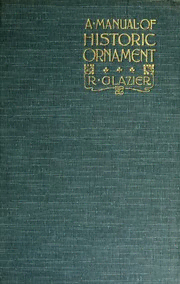
A manual of historic ornament, treating upon the evolution, tradition, and development of architecture & the applied arts; PDF
Preview A manual of historic ornament, treating upon the evolution, tradition, and development of architecture & the applied arts;
c G rJ 55,64 , 4 James M. Goode Washington, D.C. Digitized by the Internet Archive 2016 in https://archive.org/details/manualofhistoric00glaz_0 Historic Ornament. MONUMENT TO CONTE UGINO, BY MINO DA FIESOLE, CHURCH OF THE BADIA, FLORENCE. A Manual of HISTORIC ORNAMENT TREATING UPON THE EVOLUTION, TRADITION, AND DEVELOPMENT OF & ARCHITECTURE THE APPLIED ARTS PREPARED FOR THE USE OF STUDENTS AND CRAFTSMEN BY RICHARD GLAZIER HON. ASSOCIATE OF THE ROYAL COLLEGE OF ART ASSOCIATE OF THE ROYAL INSTITUTE OF BRITISH ARCHITECTS HEAD MASTER OF THE MUNICIPAL SCHOOL OF ART, MANCHESTER SECOND EDITION, REVISED AND ENLARGED WITH 600 ILLUSTRATIONS BY THE AUTHOR LONDON BATSFORD, HIGH HOLBORN B. T. 94 MCMVI Printedby S. Clarke 41, GranbyRow,Manchester THE PREFACE TO THE SECOND EDITION. HE extreme range of subjects included under His- toric Ornament necessarily implies considerable restriction and condensation in text and illustra- tion in one small volume, yet care has been taken in the selection of types to show the essentials and characteristics of national styles, and the evolution or development of design in various materials. The re-issue ofthis work has enabled the author to revise generally and also to add additional matter and illustrations in the more important sections. Thesubject ofArchitecture has received considerable amplification, as additional illustrations are given of the Greek, Romanesque, and Gothic styles, together with the Italian, French, and English Ren- ascence, making this branch of the work more comprehensive and useful to the general reader. The section dealing with the applied arts has also been enlarged, additional plates of Gold and Silver, Bronzes, Furniture, Wood- carvings, and Bookbindings being inserted, together with a number of the beautiful initial letters of the early printed books of the latter part of the i5th and the early 16th centuries, illustrating the vitality, inventiveness, and skill of the craftsmen of the past. R. G. Manchester, 1906. — REFACE. This manual has been prepared with the three-fold object of giving an elementary knowledge of Archi- tecture and Historic Ornament, of awakening a responsive and sympathetic feeling for the many beautiful and interesting remains ofancient and mediaeval civilization, and lastly, of directing the attention of students and craftsmen to the beauty, suggestiveness, and vitality of the Industrial arts of the past, and their intimate relation to the social and religious life of the people. The advantages to be derived by students and craftsmen from such a study are manifold, for, by a careful study of these arts we may see the capabilities and limitations of material, the appro- priateness and application of ornament, the continuity of line and — form yet with a marked diversity of enrichment and treatment the interest and significance of detail, and the customs, myths, and traditions of the past, with their continuity ofthought and expression. The illustrations, which have been chosen expressly for this work, are typical examples of each period or style and are produced in line as being the method best suited to the requirements of students, giving definition, emphasis, and constructive qualities of design rather than pictorial effect. In the appendix will be found a list of text-books and works of reference, which may be studied with considerable advantage by students desiring further information upon this important subject. RICHARD GLAZIER. Manchester, 1899.
